1
QuarriesBy 1809 a number of quarries were being worked in this North Shore area - most were small scale serving local communities, but a few became more important. The original Wallace quarry site by the river was acquired in 1809, but work started in 1811 and it took 17 years for it to reach completion. The land was granted to William Mackenzie in 1810, who deeded it to Isaac and Benjamin Smith, who sold it to architect Richard Smith. This later became the Battye quarry. Not far away the Battye brothers also started a brickyard.
2
5) QUARRIES - Early Quarry Site, Wallace, Nova Scotia, Canada25 August 2010
Wallace, Nova Scotia, Canada
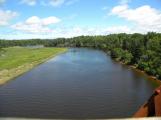 Credits:
Credits:R.Campbell
3
Erosion of the river bank exposed the sandstone, and the stone was quaried by various people: Scott, Dewar, Meade and Brunton, and Adam and Battye.The Battye family had two quarries, one on the river, and one in the village. In 1860, Thomas Battye founded the Wallace River Quarry, employing approximately 100 men. He had two ships built to carry away the stone, called "Freestone" and "Mary Anne". Ships also carried cargoes of bricks; when the weather was too mild or too rough, a small steam powered tug boat called the 'Lion" towed ships to the wharf and then back to the harbour when loaded.
When a bridge was built in 1890, a section opened to allow sailing craft to reach the brickyard and quarry wharves. A steam boat, the 'Muscologne', towed large barges of stone to various destinations. In the late 1800's an American company called the International Brown Stone Quarry Company rented the Battye Quarry on the Wallace River site, near the swing bridge, and shipped stone to New York City. Then Battye bought 14 acres (5.6 hectares) of land from Cpt. Grant and began a new quarry with a higher quality of stone. The quarry belonged to Fred and George Battye in 1894. This quarry was still active in 1900. The sandstone was a grey, buff or olive colour (that which was quarried near River John was red) and was popular with the American market. This trade collapsed when the US put high duties on Nova Scotia products. The partners went on to establish a brick yard near their quarry, but it was destroyed by fire in 1918.
4
Original Quarry Site of Wallace Quarries Ltd, Wallace, Nova Scotia, Canada25 August 2010
Wallace, Nova Scotia, Canada
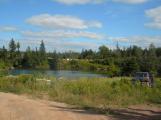 Credits:
Credits:Wallace Quarries Ltd.
5
In 1863, local man William McNab was driving fence posts into a newly purchased six acres (2.4 hectares) of land, to the back of the village. However, his fencing was put on hold when, ten inches (25 cms) down, he struck rock. He and stone mason James Drysdale got to work, clearing the soil. The first rock extracted was fine quality stone, about four inches (10.5cms) thick. McNab began employing men to work the rock, cutting the layers into flagstones and shipping them off to Prince Edward Island and Halifax for sidewalks. The stone was carried by scows to schooners offshore because at this time there were no wharves in Wallace.This quarry continues today, the modern workings to the right of the trees in the picture.
6
Heavy Lifting, Wallace, Nova Scotia, Canadalate 1800's
Wallace, Nova Scotia, Canada
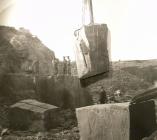 Credits:
Credits:Wallace and Area Museum
7
In 1872, the Wallace Huestis Graystone Company was formed, leasing the quarry for 20 years from McNab. Two years later, operations commenced. They erected the first cranes at the Wallace quarry, two hand cranes in the quarry with a derrick, and one at the harbour for loading. The stone was carried to Boston on the ship "Wallace". The quarry eventually expanded to Cpt. F.K. Grant's land, which became a valuable part of the quarry.8
Men on the Job, Wallace, Nova Scotia, CanadaLate 1800's
Wallace, Nova Scotia, Canada
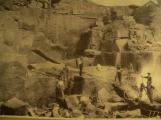 Credits:
Credits:Wallace and Area Museum
9
Derricks were used in the quarry for lifting the great blocks of stone. A complex series of pulleys, wires and blocks enabled the chunks of stone, bound in chains, to be lifted to slovens (flatbed, heavy duty wagons) which ran on narrow gauge tracks; these were pulled by horses walking between the rails. The blocks often weighed 5-7 tons. The masts had wood 'steps' attached, enabling a man to climb up and grease the pulleys to keep things running smoothly. He would sometimes show off by standing on the top!The slovens had a low bed, which made them more stable and easier to load and unload.
10
Quarry Masts, Wallace, Nova Scotia, CanadaLate 1800's
Wallace, Nova Scotia, Canada
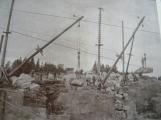 Credits:
Credits:The Flynn Family, Wallace
11
In 1885 the quarry was sold to G.P. Sherwood & Co., also the president of Dorchester Union Freestone Company. The two companies shipped stone up and down the United States east coast and Canada.Then, in 1912, Lyall & Sons purchased the quarry, modernizing it with a steam mill, electric crane, and steam shovels. They continued quarrying under the name Wallace Sandstone Quarries Ltd, then finally Wallace Quarries Ltd.
12
Wallace Gravity Train Model, Wallace, Nova Scotia, Canada20th Century
Wallace, Nova Scotia, Canada
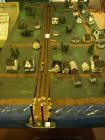 Credits:
Credits:Wallace and Area Museum
13
A gravity railroad was installed in Wallace to take the extracted stone down to the wharf to be loaded onto ships. It was finally removed in 1936. Barriers were place at each street crossed by the rail track; these barriers dropped down each time a trolly load of stone came down the hill and when an empty one went up. A semaphore signaled when a trolly was ready to go up or down the hill, which was every 20 minutes.14
Quarry Horses and Rail, Wallace, Nova Scotia, Canadaapprox. 1910
Wallace, Nova Scotia, Canada
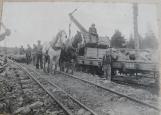 Credits:
Credits:Flynn Family, Wallace
Ellen Millard ( 'Wallace Then and Now' )